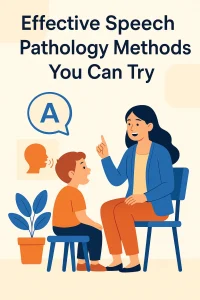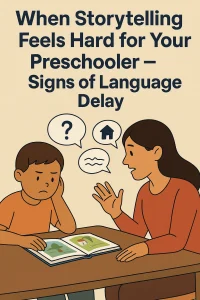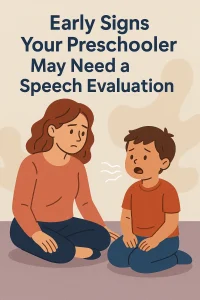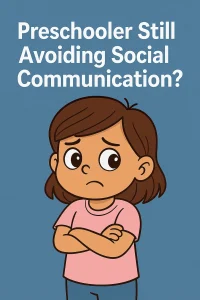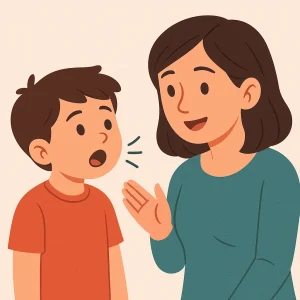Lisp: Causes, Types, and Effective Speech Therapy Tips
Last Updated: August 25, 2025
Have you ever wondered why some people have difficulty pronouncing certain sounds? This common speech issue is known as a lisp. Whether it’s a slight mispronunciation or a more noticeable speech challenge, a lisp can affect anyone, from children to adults. Understanding what a lisp is and how it impacts daily life is the first step toward finding solutions.
Free Speech Help for Kids
Concerned about speech delays? Book a free consultation with our expert speech therapist and get guidance tailored to your child’s needs.
What is a Lisp?
Definition of a Lisp
A lisp is a speech disorder characterized by the inability to correctly pronounce certain consonant sounds, most commonly the sounds associated with “s” and “z.” People with a lisp might substitute these sounds with a “th” sound or produce them in a way that sounds distorted. This speech difficulty can affect clarity and fluency, making communication a challenge.
Types of Lisps
Understanding the different types of lisps is essential in diagnosing and treating the disorder effectively. There are four primary types of lisps:
- Interdental Lisp: This is the most common type of lisp. Here, the tongue protrudes between the front teeth, causing the “s” and “z” sounds to be pronounced as “th” sounds. For example, “sun” may sound like “thun.”
- Lateral Lisp: In a lateral lisp, air flows over the sides of the tongue instead of down the middle. This results in a slushy or wet sound, making “s” and “z” sounds unclear.
- Dental Lisp: Similar to an interdental lisp, a dental lisp occurs when the tongue pushes against the front teeth, but without protruding between them. This also affects the clarity of “s” and “z” sounds.
- Palatal Lisp: This less common type occurs when the middle of the tongue touches the soft palate, or roof of the mouth, while attempting to produce “s” and “z” sounds, causing them to sound distorted.
Also read: 6 Types of Lisps and How to Correct Them
Types of Lisps and Characteristics
| Type of Lisp | Characteristics |
|---|---|
| Interdental Lisp | The tongue protrudes between the front teeth, causing the “s” and “z” sounds to be pronounced as “th” sounds, e.g., “sun” sounds like “thun”. |
| Lateral Lisp | Air flows over the sides of the tongue instead of down the middle, producing a slushy or wet sound, making “s” and “z” sounds unclear. |
| Dental Lisp | The tongue pushes against the front teeth but does not protrude between them, affecting the clarity of “s” and “z” sounds. |
| Palatal Lisp | The middle of the tongue touches the soft palate (roof of the mouth) when trying to produce “s” and “z” sounds, resulting in a distorted pronunciation. |
Common Causes of Lisps
Developmental Factors in Children
One of the most common reasons children develop a lisp is due to normal speech development. As children learn to speak, they often experiment with different sounds, and a lisp can be a part of this process. Most children outgrow these speech patterns, but for some, the lisp persists. Understanding these developmental factors is crucial for early intervention and effective treatment.
Genetics and Family History
Genetics can play a significant role in speech development, including the presence of a lisp. If family members, such as parents or siblings, had a lisp during their childhood, there’s a higher chance that a child might also develop a lisp. Recognizing the hereditary aspect can help in anticipating and addressing the issue early on.
Physical Factors
Certain physical factors can contribute to the development of a lisp:
- Tongue Tie: A condition where the tongue’s range of motion is restricted due to a short frenulum (the tissue connecting the tongue to the bottom of the mouth). This can affect speech clarity and contribute to a lisp.
- Dental Issues: Misaligned teeth, gaps, or overbites can interfere with proper tongue placement and airflow, leading to a lisp. Regular dental check-ups can help identify and manage these issues.
Know more: The Effects of Tongue-Tie on Articulation: What You Need to Know
Neurological Factors
Neurological factors can also cause or exacerbate a lisp:
- Brain Injury: Injuries to the brain can affect the areas responsible for speech production, leading to various speech disorders, including lisps.
- Neurological Disorders: Conditions such as cerebral palsy or other neurological disorders can impact muscle control and coordination, affecting speech clarity and leading to a lisp.
Common Causes of Lisps
| Cause | Description |
|---|---|
| Developmental | Normal Part of Speech Development in Children: Many children go through phases of speech development where a lisp is present. This is often temporary and can improve with age and practice. |
| Genetics | Family History of Speech Disorders: Lisps can run in families, suggesting a genetic predisposition. If parents or siblings had a lisp, a child might be more likely to develop one. |
| Physical Factors | Tongue Tie, Dental Issues: Physical conditions like a tongue tie (ankyloglossia) restrict tongue movement, while dental issues like misaligned teeth, overbites, or gaps can interfere with proper tongue placement and speech clarity. |
| Neurological Factors | Brain Injury, Neurological Disorders: Conditions affecting the brain or nervous system, such as traumatic brain injury or neurological disorders like cerebral palsy, can impair muscle control and coordination, leading to speech difficulties including lisps. |
Impact of a Lisp on Daily Life
Effects on Communication and Social Interactions
Living with a lisp can significantly impact communication and social interactions. People with a lisp might feel self-conscious about speaking, leading to reduced participation in conversations. Misunderstandings can occur more frequently, causing frustration for both the speaker and the listener. Over time, this can lead to social withdrawal and a reluctance to engage in social activities, which can affect relationships and overall quality of life.
Emotional and Psychological Impact
The emotional and psychological effects of a lisp should not be underestimated. Many individuals with a lisp experience lower self-esteem and confidence due to their speech impediment. They might face teasing or bullying, especially in school settings, which can lead to anxiety and depression. It’s important to address these emotional challenges as part of a comprehensive treatment plan to ensure overall well-being.
Academic and Professional Implications
In academic settings, a lisp can hinder a student’s ability to participate in class discussions, presentations, and other activities that require clear communication. This can affect their academic performance and opportunities for leadership roles. Professionally, adults with a lisp might encounter similar challenges, such as difficulties in job interviews, presentations, and daily workplace interactions. Effective communication is key in many professions, and a lisp can create obstacles in career advancement and professional relationships.
Diagnosing a Lisp
Signs and Symptoms to Watch For
Identifying a lisp early on can make a significant difference in effective treatment. Common signs and symptoms to watch for include:
- Pronunciation Difficulties: Substituting “s” and “z” sounds with “th” sounds, or producing slushy or unclear sounds.
- Tongue Placement Issues: Noticeable protrusion of the tongue between the teeth or against the front teeth when speaking.
- Speech Clarity Problems: Speech that is difficult to understand, especially in noisy environments or during rapid speech.
- Repetitive Errors: Consistent mispronunciations across different contexts and speaking situations.
Read more: Speech Sound Errors in Children: Milestones and When to Seek Help
When to Seek Professional Help
While some children may naturally outgrow a lisp, it’s important to seek professional help if:
- The lisp persists beyond early childhood.
- The lisp affects the child’s ability to be understood by others.
- There are concerns about the child’s social interactions or self-esteem due to their speech.
- An adult develops a lisp suddenly, which could indicate an underlying medical condition.
Early intervention can prevent a lisp from becoming a long-term issue and help improve communication skills significantly.
Role of Speech-Language Pathologists
Speech-language pathologists (SLPs) play a crucial role in diagnosing and treating lisps. They are trained to:
- Assess Speech Patterns: Conduct thorough evaluations to understand the nature and severity of the lisp.
- Develop Treatment Plans: Create personalized therapy plans tailored to the individual’s needs, incorporating exercises and techniques to correct tongue placement and improve speech clarity.
- Provide Support and Resources: Offer guidance to families and individuals on how to support speech development at home and in daily activities.
Treatment Options for Lisps
Speech Therapy Techniques
Speech therapy is the most effective way to treat a lisp. A speech-language pathologist (SLP) will tailor therapy techniques to address the specific type of lisp and its severity. Common techniques include:
- Articulation Therapy: Focuses on teaching correct tongue placement and movement to produce clear “s” and “z” sounds.
- Auditory Discrimination: Helps individuals recognize the difference between correct and incorrect sounds.
- Phonetic Placement: Uses visual aids and physical tools to guide the correct placement of the tongue and teeth.
These techniques are designed to gradually improve speech clarity and reduce the occurrence of lisping.
At-Home Exercises and Practices
In addition to professional speech therapy, at-home exercises can reinforce progress. Some helpful practices include:
- Tongue Twisters: Practicing tongue twisters that focus on “s” and “z” sounds can improve articulation and speed.
- Mirror Exercises: Using a mirror to monitor tongue placement while speaking helps ensure correct pronunciation.
- Reading Aloud: Regularly reading aloud passages that include many “s” and “z” sounds can enhance speech fluency.
- Practice Sheets: Utilizing practice sheets with specific words and phrases to repeat can build muscle memory for correct articulation.
Medical and Dental Interventions
For some individuals, medical or dental issues may contribute to a lisp. Interventions might include:
- Dental Work: Correcting dental misalignments, gaps, or overbites can improve speech clarity. Regular dental check-ups are essential for identifying and addressing these issues.
- Surgical Procedures: In cases of tongue tie or other physical abnormalities, minor surgical procedures might be necessary to allow proper tongue movement.
Long-Term Management and Support
Long-term management of a lisp requires ongoing support and practice. Key strategies include:
- Regular Check-Ins: Continual sessions with a speech-language pathologist to monitor progress and adjust techniques as needed.
- Supportive Environment: Encouraging family and friends to be supportive and patient during the treatment process.
- Consistent Practice: Maintaining regular practice of speech exercises to reinforce correct articulation and prevent regression.
Conclusion
Living with a lisp can be challenging, but understanding it is the first step to overcoming it. We’ve discussed what a lisp is, the different types, and common causes like developmental factors, genetics, physical issues, and neurological conditions. The impact of a lisp on daily life includes difficulties in communication, emotional well-being, and academic or professional performance. Diagnosing a lisp involves recognizing signs, knowing when to seek help, and understanding the role of speech-language pathologists. Treatment options include speech therapy, at-home exercises, medical and dental interventions, and long-term management strategies.
If you or a loved one has a lisp, seeking help is important. Early intervention can make a big difference. Professional guidance from a speech-language pathologist provides the tools and techniques needed to improve speech clarity. Remember, overcoming a lisp takes patience and practice. At Wellness Hub, we are here to support you with tailored treatment plans and resources. Clear and confident speech is possible with the right approach and dedication. Let’s work together to improve communication skills and quality of life.
Frequently Asked Questions:
1. What causes a lisp in speech?
A lisp can be caused by various factors including developmental issues, genetics, physical conditions like tongue tie or dental problems, and neurological disorders.
2. How can I fix my lisp?
Fixing a lisp often involves speech therapy, practicing at-home exercises, and sometimes medical or dental interventions. A speech-language pathologist can create a personalized treatment plan.
3. Is a lisp a speech disorder?
Yes, a lisp is considered a speech disorder that affects the clarity of certain sounds, particularly “s” and “z.”
4. Can speech therapy help with a lisp?
Absolutely. Speech therapy is one of the most effective ways to treat a lisp. A speech-language pathologist can teach techniques to improve articulation and reduce lisping.
5. Why do people develop a lisp?
People can develop a lisp due to a variety of reasons including genetic factors, physical abnormalities like tongue tie or dental issues, developmental factors, and neurological conditions.
6. At what age should I seek help for my child’s lisp?
If your child’s lisp persists beyond early childhood or if it affects their ability to be understood, it’s a good idea to seek help from a speech-language pathologist.
7. Are there different types of lisps?
Yes, there are several types of lisps including interdental, lateral, dental, and palatal lisps. Each type affects speech in different ways.
8. Can adults develop a lisp?
Yes, adults can develop a lisp, particularly if they have a neurological condition or have suffered a brain injury.
9. Are there exercises I can do at home to help with a lisp?
Yes, there are several at-home exercises that can help, such as practicing tongue twisters, using a mirror to monitor tongue placement, and reading aloud passages with “s” and “z” sounds.
10. How long does it take to correct a lisp?
The time it takes to correct a lisp varies depending on the severity of the lisp and the consistency of practice and therapy. With regular speech therapy and practice, significant improvements can often be seen within a few months.
About the Author:
Anuradha Karanam
Speech-language pathologist (7+ years of experience)
Anuradha Karanam is a skilled speech-language pathologist with over 6 years of experience. Fluent in Tamil, Telugu, Hindi, and English, she specializes in parent counseling, speech sound disorders, fluency assessment, and speech-language evaluations. Anuradha excels at working with children with developmental disorders, offering creative and effective therapy programs. Currently, at Wellness Hub, she holds a BASLP degree and is registered with the RCI (CRR No A85500). Her patience, ambition, and dedication make her a trusted expert in her field.
Connect with Anuradha to learn more about how she can help you or your loved one find their voice.
Book your Free Consultation Today
Parent/Caregiver Info:
Client’s Details:
* Error Message




